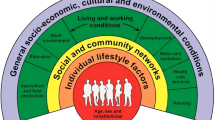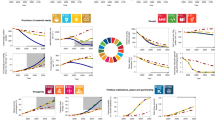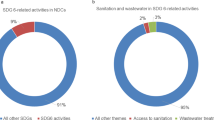Abstract
The unprecedented rise in cooling demand globally is a critical blind spot in sustainability debates. We examine cooling as a system comprised of active and passive measures, with key social and technical components, and explain its link to all 17 Sustainable Development Goals. We propose an analytical and solution-oriented framework to identify and shape interventions towards sustainable cooling. The framework comprehends demand drivers; cradle-to-cradle stages; and system change levers. By intersecting cooling stages and levers, we discuss four specific, exemplary interventions to deliver sustainable cooling. We propose an agenda for research and practice to transition towards sustainable cooling for all.
This is a preview of subscription content, access via your institution
Access options
Access Nature and 54 other Nature Portfolio journals
Get Nature+, our best-value online-access subscription
$29.99 / 30 days
cancel any time
Subscribe to this journal
Receive 12 digital issues and online access to articles
$119.00 per year
only $9.92 per issue
Buy this article
- Purchase on Springer Link
- Instant access to full article PDF
Prices may be subject to local taxes which are calculated during checkout


Similar content being viewed by others
References
Cooper, G. Air-Conditioning America: Engineers and the Controlled Environment, 1900-1960 (Johns Hopkins Univ. Press, 1998).
Ackermann, M. Cool Comfort: America’s Romance with Air-Conditioning (Smithsonian Institution Press, 2002).
Cox, S. Losing our Cool: Uncomfortable Truths about our Air-Conditioned World (and Finding New Ways to get Through the Summer) (New Press, 2012).
Berger, M. W. Cool comfort: America’s romance with air-conditioning (review). Technol. Cult. 45, 452–454 (2004).
Davis, L. W. & Gertler, P. J. Contribution of air conditioning adoption to future energy use under global warming. Proc. Natl Acad. Sci. USA 112, 5962–5967 (2015).
Heatwaves and Health: Guidance on Warning-System Development (World Meteorlogical Organization and World Health Organization, 2015).
Mastrucci, A., Byers, E., Pachauri, S. & Rao, N. D. Improving the SDG energy poverty targets: residential cooling needs in the Global South. Energy Build. 186, 405–415 (2019).
The Future of Cooling - Opportunities for Energy Efficient Air Conditioning (International Energy Agency, 2018); https://www.iea.org/reports/the-future-of-cooling
Peters, T. A Cool World - Defining the Energy Conundrum of Cooling for All (Univ. of Birmingham, 2018).
Fuso Nerini, F. et al. Mapping synergies and trade-offs between energy and the Sustainable Development Goals. Nat. Energy 3, 10–15 (2018).
Fuso Nerini, F. et al. Connecting climate action with other Sustainable Development Goals. Nat. Sustain. 2, 674–680 (2019).
Thacker, S. et al. Infrastructure for sustainable development. Nat. Sustain. 2, 324–331 (2019).
Research Projects (International Institute of Refrigeration, 2018); https://iifiir.org/en/european-and-international-projects
Global Cooling Prize (Rocky Mountain Institute, 2018); https://globalcoolingprize.org/
She, X. et al. Energy-efficient and -economic technologies for air conditioning with vapor compression refrigeration: a comprehensive review. Appl. Energy 232, 157–186 (2018).
Stephenson, J. et al. Energy cultures: a framework for understanding energy behaviours. Energy Policy 38, 6120–6129 (2010).
Wilhelmi, O. V. & Hayden, M. H. Connecting people and place: a new framework for reducing urban vulnerability to extreme heat. Environ. Res. Lett. 5, 14021 (2010).
Lunt, M. F. et al. Reconciling reported and unreported HFC emissions with atmospheric observations. Proc. Natl Acad. Sci. USA 112, 5927–5931 (2015).
Myhre, G. et al. in Climate Change 2013: The Physical Science Basis (eds Stocker, T. F. et al.) Ch. 8 (Cambridge Univ. Press, 2013).
Ürge-Vorsatz, D., Cabeza, L. F., Serrano, S., Barreneche, C. & Petrichenko, K. Heating and cooling energy trends and drivers in buildings. Renew. Sustain. Energy Rev. 41, 85–98 (2015).
Waite, M. et al. Global trends in urban electricity demands for cooling and heating. Energy 127, 786–802 (2017).
Geels, F. W. From sectoral systems of innovation to socio-technical systems: insights about dynamics and change from sociology and institutional theory. Res. Policy 33, 897–920 (2004).
Costanza, R. & Daly, H. E. Natural capital and sustainable development. Conserv. Biol. 6, 37–46 (1992).
Elmqvist, T. et al. Sustainability and resilience for transformation in the urban century. Nat. Sustain. 2, 267–273 (2019).
Sachs, J. D. et al. Six transformations to achieve the Sustainable Development Goals. Nat. Sustain. 2, 805–814 (2019).
Seto, K. C. et al. Carbon lock-in: types, causes, and policy implications. Annu. Rev. Environ. Resour. 41, 425–452 (2016).
Park, R. J., Goodman, J., Hurwitz, M. & Smith, J. Heat and learning. Am. Econ. J. Econ. Policy 12, 306–339 (2020).
Barreca, A., Clay, K., Deschenes, O., Greenstone, M. & Shapiro, J. S. Adapting to climate change: the remarkable decline in the US temperature-mortality relationship over the twentieth century. J. Polit. Econ. 124, 105–159 (2016).
Markard, J., Raven, R. & Truffer, B. Sustainability transitions: an emerging field of research and its prospects. Res. Policy 41, 955–967 (2012).
Cherp, A., Vinichenko, V., Jewell, J., Brutschin, E. & Sovacool, B. Integrating techno-economic, socio-technical and political perspectives on national energy transitions: a meta-theoretical framework. Energy Res. Soc. Sci. 37, 175–190 (2018).
Loorbach, D. Transition management for sustainable development: a prescriptive, complexity‐based governance framework. Governance 23, 161–183 (2010).
Hekkert, M. P., Suurs, R. A. A., Negro, S. O., Kuhlmann, S. & Smits, R. E. H. M. Functions of innovation systems: a new approach for analysing technological change. Technol. Forecast. Soc. Change 74, 413–432 (2007).
Farmer, J. D. et al. Sensitive intervention points in the post-carbon transition. Science 364, 132–134 (2019).
Newell, R. G., Jaffe, A. B. & Stavins, R. N. The Induced Innovation Hypothesis and Energy-Saving Technological Change NBER Working Paper No. 6437 (National Bureau of Economic Research, 1998); https://doi.org/10.3386/w6437
Biddle, J. Explaining the spread of residential air conditioning, 1955-1980. Explor. Econ. Hist. 45, 402–423 (2008).
Creutzig, F. et al. Towards demand-side solutions for mitigating climate change. Nat. Clim. Change 8, 260–263 (2018).
Foss, N. J. & Saebi, T. Fifteen years of research on business model innovation. J. Manage. 43, 200–227 (2017).
De Vecchi, R., Cândido, C. & Lamberts, R. Thermal history and its influence on occupants’ thermal acceptability and cooling preferences in warm-humid climates: a new desire for comfort. In Proceedings of 7th Windsor Conference: The Changing Context of Comfort in an Unpredictable World (Network for Comfort and Energy Use in Buildings, 2012); https://windsorconference.com/proceedings/
Park, C., Lee, H., Hwang, Y. & Radermacher, R. Recent advances in vapor compression cycle technologies. Int. J. Refrig. 60, 118–134 (2015).
Rogge, K. S. & Reichardt, K. Policy mixes for sustainability transitions: an extended concept and framework for analysis. Res. Policy 45, 1620–1635 (2016).
Tvinnereim, E. & Mehling, M. Carbon pricing and deep decarbonisation. Energy Policy 121, 185–189 (2018).
Karali, N. et al. Improving the energy efficiency of room air conditioners in China: costs and benefits. Appl. Energy 258, 114023 (2020).
Creutzig, F. et al. Beyond technology: demand-side solutions for climate change mitigation. Annu. Rev. Environ. Resour. 41, 173–198 (2016).
Gustavsson, J., Cederberg, C., Sonesson, U., Van Otterdijk, R. & Meybeck, A. Global Food Losses and Food Waste (FAO, 2011).
Building Momentum for Impact - K-CEP Year Three Report (K-CEP, 2020); https://www.k-cep.org/year-three-report/
Off-Grid Solar Market Trends Report 2020 (World Bank Group, 2020).
Cooling as a Service (CaaS) (K-CEP, 2019); https://go.nature.com/2RYZKCE
Bai, X. et al. Six research priorities for cities. Nature 555, 23–25 (2018).
Santamouris, M. & Kolokotsa, D. Passive cooling dissipation techniques for buildings and other structures: the state of the art. Energy Build. 57, 74–94 (2013).
Aram, F., Higueras García, E., Solgi, E. & Mansournia, S. Urban green space cooling effect in cities. Heliyon 5, e01339 (2019).
Dong, J. et al. Quantitative study on the cooling effect of green roofs in a high-density urban area—a case study of Xiamen, China. J. Clean. Prod. 255, 120152 (2020).
Meerow, S. The politics of multifunctional green infrastructure planning in New York City. Cities 100, 102621 (2020).
Montreal Protocol on Subtances that Deplete the Ozone Layer (Ozone Secretariat United Nations Environment Programme, 1987).
Hitchings, R. & Lee, S. J. Air conditioning and the material culture of routine human encasement: the case of young people in contemporary Singapore. J. Mater. Cult. 13, 251–265 (2008).
Fujii, H. & Lutzenhiser, L. Japanese residential air-conditioning: natural cooling and intelligent systems. Energy Build. 18, 221–233 (1992).
Cerda Planas, L. moving toward greener societies: moral motivation and green behaviour. Environ. Resour. Econ. 70, 835–860 (2018).
Ebeling, F. & Lotz, S. Domestic uptake of green energy promoted by opt-out tariffs. Nat. Clim. Change 5, 868–871 (2015).
Otto, I. M. et al. Social tipping dynamics for stabilizing Earth’s climate by 2050. Proc. Natl Acad. Sci. USA 117, 2354–2365 (2020).
Moloney, S., Horne, R. E. & Fien, J. Transitioning to low carbon communities-from behaviour change to systemic change: lessons from Australia. Energy Policy 38, 7614–7623 (2010).
Ürge-Vorsatz, D. et al. Advances toward a global net zero building sector. Annu. Rev. Environ. Resour. 45, https://doi.org/10.1146/annurev-environ-012420-045843 (2020).
Werner, S. International review of district heating and cooling. Energy 137, 617–631 (2017).
Bhamare, D. K., Rathod, M. K. & Banerjee, J. Passive cooling techniques for building and their applicability in different climatic zones—the state of art. Energy Build. 198, 467–490 (2019).
Feyisa, G. L., Dons, K. & Meilby, H. Efficiency of parks in mitigating urban heat island effect: An example from Addis Ababa. Landsc. Urban Plan. 123, 87–95 (2014).
Acknowledgements
We acknowledge the support provided by the Future of Cooling Programme at the Oxford Martin School, University of Oxford.
Author information
Authors and Affiliations
Contributions
R.K. led the manuscript conception, design and writing. N.D.M. led data acquisition and analysis on the links between cooling and the SDGs. R.K., N.D.M. and P.A.T. wrote the introduction and the section on cooling and SDG links. A.M. developed the framework visuals. N.D.M., P.A.T., A.M., R.R. and C.M. contributed to the framework writing. A.J., P.A.T. and M.M. contributed to the future agenda. R.K., P.A.T., F.C., M.M. and R.P.-S. revised the manuscript. All authors contributed towards the design of the work and the editing of the manuscript.
Corresponding author
Ethics declarations
Competing interests
The authors declare no competing interests.
Additional information
Publisher’s note Springer Nature remains neutral with regard to jurisdictional claims in published maps and institutional affiliations.
Supplementary information
Supplementary Information
Supplementary Discussion, Figs. A.1 and A.2, and Tables A.1, A.2, B.1 and C.1.
Rights and permissions
About this article
Cite this article
Khosla, R., Miranda, N.D., Trotter, P.A. et al. Cooling for sustainable development. Nat Sustain 4, 201–208 (2021). https://doi.org/10.1038/s41893-020-00627-w
Received:
Accepted:
Published:
Issue Date:
DOI: https://doi.org/10.1038/s41893-020-00627-w
This article is cited by
-
Urban water and electricity demand data for understanding climate change impacts on the water-energy nexus
Scientific Data (2024)
-
Enhancing University Performance Evaluation through Digital Technology: A Deep Learning Approach for Sustainable Development
Journal of the Knowledge Economy (2024)
-
Understanding systemic cooling poverty
Nature Sustainability (2023)
-
Change in cooling degree days with global mean temperature rise increasing from 1.5 °C to 2.0 °C
Nature Sustainability (2023)
-
Green and Social Regulation of Second Hand Appliance Markets: the Case of Air Conditioners in the Philippines
Circular Economy and Sustainability (2023)



